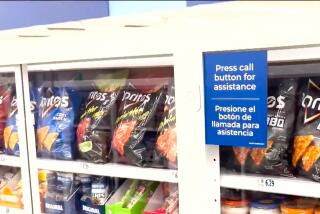Green to Take Control at Rite Aid
- Share via
Ailing drugstore retailer Rite Aid Corp. said Monday that Los Angeles-based buyout king Leonard Green will take over as chairman of the company he helped build in 1996 when he sold the Thrifty Payless chain to Rite Aid.
Green, who along with his investment fund controls as much as 11% of Camp Hill, Pa.-based Rite Aid, would replace Martin Grass, who resigned as chairman and chief executive amid criticism last month.
Although Green said he expects the appointment will be a short-lived one, Wall Street reaction was mostly positive. Some industry observers expressed reservations because Green’s focus is on making money primarily for his own investors and not necessarily on the firm’s longer-term health.
“This is an under-managed asset, but an asset,” said Jonathan H. Ziegler, a food and drug retailing analyst at Deutsche Banc Alex. Brown. “Leonard knows retailing, Leonard is being paid a retainer and Leonard has capital in the company. Putting him in there is a way of showing something is being done.”
Rite Aid also announced Monday that it was changing its auditor. Since Grass’ departure, a thinned management team has been led by interim Chief Executive Timothy J. Noonan, the former chief operations officer for the company, who will continue as CEO until a permanent replacement is named.
Green said he didn’t want to give a time frame for his tenure. He said there are active discussions with several management candidates, adding that he hoped his time at the helm will be “relatively short.” Green’s appointment follows last month’s investment in Rite Aid of $300 million through a fund he controls.
Grass, the son of Rite Aid’s founder, faced criticism for allegedly improper personal deals with the public company as well as failing to integrate Rite Aid’s spiraling acquisitions--including its largest undertaking, the $2.4-billion addition of Thrifty Payless.
“There’s nothing wrong with this company that a reduction of debt won’t cure,” Green said.
Along with his Leonard Green & Partners, Green, 66, made his fortune rescuing the “dogs” of the retail industry, becoming the nation’s leading retail buyout specialist. While his efforts have yielded mixed results, the overall returns to his investors have been enormous.
Many on Wall Street viewed Green’s appointment as reassurance to investors that the company is in experienced hands. Rite Aid was this year’s worst-performing company in the benchmark Standard & Poor 500 index, with an 85% decline in stock value.
“Green is capable of ensuring the business is managed with discipline until a full-time CEO is brought on board in the next couple of months,” said analyst Eric Bosshard of Midwest Research in St. Louis.
Rite Aid’s stock closed up 56 cents at $7.38 on the New York Stock Exchange--far off its January high of $51.13, but improved from a November low of $4.50.
Since its fortunes began declining, Rite Aid has said it will consider selling as many as 350 West Coast stores--with some reports suggesting the company will divest itself of the entire Thrifty holding, an assertion the company denied. Rite Aid has about 3,800 stores nationwide.
Rite Aid executives also are weighing the sale or partial sale of PCS Health Systems, one of the country’s largest prescription-drug benefits management companies, which Rite Aid bought for a hefty $1.5 billion earlier this year.
“When you think of the transactions they are discussing, having a deal maker in there will be very helpful,” said Ken Moelis, a managing director with Donaldson Lufkin & Jenrette in Los Angeles. “Leonard will do what it takes to make this work.”
Between 1990 and 1997, Green’s investment bets have averaged an annual compound return of 81% for investors such as the California Public Employees’ Retirement System, the Pennsylvania state teachers pension fund, Wells Fargo & Co. and Citicorp. A small percentage of his investors, about 5%, are high net worth individuals, Green said.
Leonard Green & Partners’ bailouts include a failure with Hechinger Co., which Green took on in 1997 and which filed for U.S. Bankruptcy Court protection in June.
In a 1997 interview, however, Green said Thrifty provided investors with a compounded annualized 118% return on their initial $37-million investment, following its merger with Payless Drug and subsequent absorption by Rite Aid.
Rite Aid also made two other announcements Monday. It said accounting firm KPMG International is stepping down as its auditor, following an announcement last week that the company would for a second time restate earnings from the last three years.
It also said Beth Kaplan, senior executive vice president of marketing, will resign, though it released no reasons for her departure.
(BEGIN TEXT OF INFOBOX / INFOGRAPHIC)
Green’s Investments
Other recent investments by Leonard Green & Partners, which recently infused $300 million into ailing Rite Aid Corp.:
*--*
Deal size Business Company Date (millions) description Centers Holdings Sept. 1997 $800 Do-it-yourself home improvement Liberty Group Jan. 1998 329 Local newspapers Publishing in rural markets Dollar Financial Group Dec. 1998 248 Check cashing/ consumer services Wavetek June 1997 215 Electronic testing instruments Intercontinental Art Aug. 1999 199 Distributor: framed art to retail stores Diamond Triumph March 1998 170 Automotive glass Auto Glass replacement/repair
*--*
Source: Leonard Green & Partners
More to Read
Inside the business of entertainment
The Wide Shot brings you news, analysis and insights on everything from streaming wars to production — and what it all means for the future.
You may occasionally receive promotional content from the Los Angeles Times.









